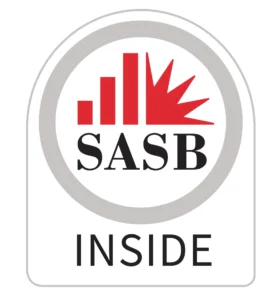by Phil Molé, MPH
On June 26, 2023, International Sustainability Standards Board (ISSB) issued its first two finalized ESG standards, after review and incorporation of significant stakeholder feedback that followed publication of the standards as drafts for public comment last year. Business leaders, investors, non-governmental organizations (NGOs) and other stakeholders will likely welcome these standards and their streamlined approach to ESG disclosures that build upon existing standards. Anyone involved in or interested in ESG as a management framework will need to understand these standards and keep an eye on ISSB’s future research and standards development work.
Read on for more details about ISSB’s publication of its inaugural standards, and a discussion of what to expect from ISSB in the future.
What’s the Background of ISSB’s Standards?
The story of ISSB starts with the rise of ESG as a major approach to business management during the last few years. As evidence mounted that ESG maturity correlates with better profitability and better ability to avoid business disruptions and drops in share price, ESG won acceptance as the new standard in business excellence.
But with greater emphasis on ESG performance came greater emphasis on ESG disclosures, and with greater focus on disclosures came a proliferation of disclosure frameworks. Understandably, companies, financial institutions, and public stakeholders began asking for a more streamlined ESG reporting framework to improve their ability to monitor risks and opportunities. Stakeholders wanted a reliable ESG reporting framework to support reliable disclosures. They also preferred that the framework wouldn’t “reinvent the wheel” but would build upon existing reporting frameworks and be usable by organizations around the world.
The International Financial Reporting Standards (IFRS) Foundation® addressed the growing demands for a consolidated reporting framework by forming the ISSB on November 3, 2021, at the COP26 event in Glasgow, Scotland. The IFRS’s financial accounting standards are currently accepted in 140 countries, so the Foundation had a good vantage point upon which to build and consolidate ESG reporting frameworks.
Shortly after their formation, ISSB’s page stated that the Board will, “deliver a comprehensive global baseline of sustainability-related disclosure standards that provide investors and other capital market participants with information about companies’ sustainability-related risks and opportunities to help them make informed decisions.” The page also stated that ISSB’s standards would cover important ESG topics, including climate risks, and will build upon existing general standards such as those issued by Sustainability Accounting Standards Board (SASB) and Task Force on Climate-Related Financial Disclosures (TCFD), while also developing industry-specific standards.
On March 31, 2022, ISSB published its first standards in “exposure draft” form for public comment:
IFRS S1 – “General Requirements for Disclosure of Sustainability-related Financial Information” (the General Requirements Standard)
IFRS S1 states that disclosure of sustainability-related risks and opportunities in ISSB standards be centered around the four pillars of governance, strategy, risk management, and metrics and targets. It also establishes that ISSB uses a financial materiality lens for determining the ESG information they consider important. From this perspective, ESG issues are material if they can impact investor value, such as by affecting business performance or share price, and represent information that investors would need to assess enterprise value.
IFRS S2 – “Climate-related Disclosures” (the Climate Standard)
IFRS S2 states that companies following the standard would need to disclose their absolute Scopes — 1 (direct emissions from operations), 2 (from energy use), and 3 (from their broader value chain) greenhouse gas (GHG) emissions—as well as the intensity of those emissions per unit of economic or physical output. Businesses have historically had the most difficult time tracking Scope 3 GHGs because they’re not under the company’s direct control – one example would be emissions associated with treatment, storage, and disposal facilities (TSDFs) that treat the company’s waste. GHG Protocol’s Scope 3 Standard, which is the most accepted accounting reference for Scope 3 GHGs, lists 15 separate categories of Scope 3 emissions, and IFRS S1 indicates that companies would base their GHG accounting on the GHG Protocol categories. Companies following the standard would also need to disclose information on their plans or targets related to climate issues, and how transition climate risks could impact their business model, strategy, and cash flows.

The public comment period for the proposed standards closed on July 29, 2022, after which ISSB began sifting through and analyzing stakeholder feedback. At its October 2022 meeting, ISSB voted on several measures regarding how to move forward on its standards, including retention of the requirement for companies following IFRS S1 to disclose all three scopes of GHGs but potentially allowing more time for companies to start disclosing them, and confirmation that the standards would use a financial materiality perspective, as in existing IFRS standards on financial disclosures. In press releases issued since the October 2022 meeting, ISSB had indicated a planned timeline of late Q2 2023 for finalizing and publishing the two standards.
When Did ISSB Publish Its Finalized Standards?
ISSB’s first finalized standards were published on June 26, 2023. A press release announcing the publication of the standards stated that ISSB would officially launch the standards at IFRS Foundation’s annual conference, which also began on June 26, 2023.
According to ISSB’s pages for the standards, both IFRS S1 and IFRS S2 are effective for annual reporting periods beginning on or after January 1, 2024. ISSB states that earlier application of either standard is possible, as long as the organization doing so applies both standards in the same timeframe. In other words, ISSB designed the standards to be used together.
There are no major surprises in ISSB’s first finalized standards, since ISSB had already organized votes on several key areas of the standards in its October 2022 meeting and publicized the results. As expected, ISSB is giving companies an additional year to include Scope 3 information in disclosures made following IFRS S1 and will be providing specific guidance to help companies measure and report their Scope 3 GHGs. ISSB has also used the same definition of “materiality” in its standards that is currently used in IFRS accounting standards.
ISSB and IFRS Foundation believe the inaugural standards answer industry demand for more reliable ESG disclosures in global capital markets. Emmanuel Faber, ISSB chair, stated in the press release:
“Today represents the outcome of more than 18 months of intense work to deliver an inaugural set of sustainability disclosure standards for the global capital markets. The ISSB Standards have been designed to help companies tell their sustainability story in a robust, comparable and verifiable manner. We have consulted closely with the market to ensure the Standards are proportionate and will result in disclosures that are relevant for investment decision-making.”
What Happens Next with ISSB’s Standards?
Stakeholders throughout industry had been waiting for ISSB’s first finalized standards, but now that they’ve finally appeared, what’s next? ISSB itself gives some details in its most recent press release.
According to the release and other information issued by ISSB and IFRS Foundation, here are the next steps we can expect from ISSB.
Supporting Adoption of the Standards
According to the press release, ISSB will be targeting efforts to work alongside companies and jurisdictions to facilitate adoption of the two standards. These efforts will include creation of a Transition Implementation Group to support companies seeking to apply the standards and launching “capacity building initiatives” to support adoption and implementation issues around the world. Time will tell what some of these “capacity building initiatives” may entail.
Working with Other Jurisdictions and Standards Setting Bodies
Back at its October 2022 meeting, as reported in our blog shortly thereafter, ISSB indicated a plan to continue working with other standards setting agencies to facilitate compatibility of their standards with other jurisdictional requirements. Our blog noted that ISSB had stated its intention to continue working with agencies such as European Financial Reporting Accounting Group (EFRAG) to improve alignment with their standards, and that ISSB standards provide a good foundation for jurisdictional standards-developing agencies to build upon.
ISSB’s comments in its June 26th press release reiterate those commitments. In it, ISSB states that it would continue working with Global Reporting Initiative (GRI) to improve efficiency and effectiveness when companies use ISSB standards in conjunction with other disclosure standards. GRI is an ideal partner in this effort, because GRI has also tried to foster better harmonization among standards, particularly when it comes to helping standards setting bodies using a financial materiality perspective understand the approach of standards setting bodies using a double materiality framework.
In a recent interview, ISSB chair Emmanuel Faber responded to a question about how ISSB’s standards fit into the existing disclosure landscape by saying:
“Companies have been wrestling with a complex reporting landscape for some time. This is a core reason why the ISSB was created. Our standards have been developed by consolidating voluntary initiatives. Among others, we have built our standards using other previously established work, including the industry specific SASB standards (which are now a part of the International Financial Reporting Standards Foundation, or IFRS Foundation), as well as the TCFD recommendations, so companies that have already adopted these will be in a great place to apply IFRS S1 and IFRS S2. Companies applying ISSB standards will be fully compliant with the TCFD recommendations.”

In the same interview, Faber reiterated that ISSB is collaborating with GRI, stating that ISSB and GRI had established a memorandum of understanding in 2022 to “align their work programs and standards-setting activities.”
Development of Additional ESG Standards
For the benefit of anyone who thought otherwise: ISSB’s first finalized standards were never going to be a “one and done” kind of situation. The IFRS Foundation didn’t create a whole new standards-setting body just to do some quick work assimilating existing standards and call it a day. ISSB has consistently called its two standards to date its “first” standards, while also stating the intention to develop standards in additional areas addressing other areas of ESG.
And in their June 26th press release, IFRS Foundation Monitoring Board Chair Takashi Nagaoka said, “We will continue to collaborate closely with the leadership of the ISSB and the IFRS Foundation Trustees, and remain focused on supporting the ISSB’s ongoing and future work including on other sustainability topics beyond climate (emphasis added), to ensure continued robust governance, due process and oversight of the Foundation and its standard-setting boards.”
What additional ESG topics might ISSB address in the future? We can get a clue by looking at the first batch of ESG standards issued by European Financial Reporting Advisory Group (EFRAG) in the EU. As discussed in a previous blog, EFRAG has also made progress on its initial ESG disclosure standards, finalizing them in late 2022, and preparing for them to come into force in early 2024 for approximately 50,000 EU companies as well as certain foreign companies that conduct business in the EU. The EFRAG standards address many areas of ESG not yet addressed yet in ISSB’s standards, including water and marine resources, resource use and the circular economy, biodiversity, workers in the value chain, and impacts on affected communities.
Many other stakeholders in the ESG space, including GRI, increasingly identify these additional areas of ESG as important for any meaningful and lasting progress, especially because some of them, like biodiversity and marine life, are directly linked to management of climate risks and opportunities in the view of many scientists. For example, marine life is linked to climate change because many marine species, including mangroves and corals, help sequester carbon dioxide, so when these species are threatened, there is less sequestration occurring, and more carbon dioxide reaches the atmosphere where it contributes to climate change.
In a May 2023 press release, ISSB issued a Request for Information (RFI) called “Consultation on Agenda Priorities” that includes an online survey stakeholders can use to provide feedback on
- the strategic direction and balance of the ISSB’s activities;
- the criteria for assessing which sustainability-related matters to prioritize—including topics, industries, and activities; and
- the scope and structure of potential new research and standard-setting projects.
The RFI also indicates that ISSB has identified four potential sustainability-related research projects:
1) biodiversity, ecosystems, and ecosystem services;
2) human capital;
3) human rights; and
4) researching integration in reporting. Specifically, the reporting would focus on interdependencies, synergies and trade-offs between a company’s own resources and relationships and examine how the that the value a company creates for itself is connected to the value it creates for other stakeholders, society, and the natural environment.
Businesses should understand that many industry stakeholders will view ISSB’s first finalized standards as integral to demonstrating ESG maturity and operational excellence. While companies should certainly anticipate and plan for additional ISSB standards in other areas of ESG, they should prioritize firming up their approach to climate risks and opportunities. That includes having efficient ways to collect, track and disclose all three scopes of GHG emissions.
Let VelocityEHS Help!
The ESG Solution, part of the VelocityEHS Accelerate® Platform, gives you the support you need to obtain, manage, and report the kind of investment-grade GHG data needed to follow ISSB’s first finalized standards. Our Utility Data Sync capability interfaces directly with your utility providers to automatically collect energy data, apply correct emission factors for calculating Scope 2 emissions, and convert your data to the right units, minimizing potential for error and administrative burdens. The solution also gives you the ability to track all three scopes of your GHG emissions, with simplified out-of-the-box reporting capabilities.
Request a demo today to learn more about how VelocityEHS can support you as you build and maintain a world-class ESG management system.
Introducing ESG QuickTakes: A Sustainability E-Newsletter!
Master ESG with our NEW quarterly publication. Get expert insights on regulations, energy management, and sustainability delivered straight to your inbox.
